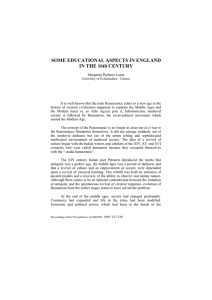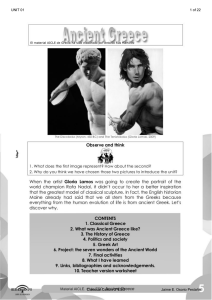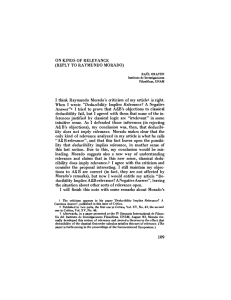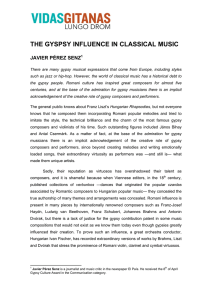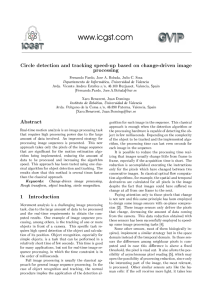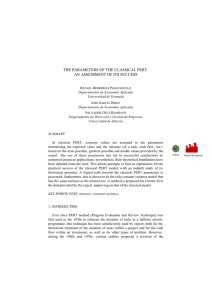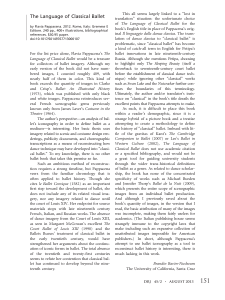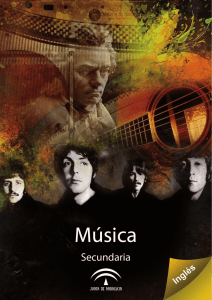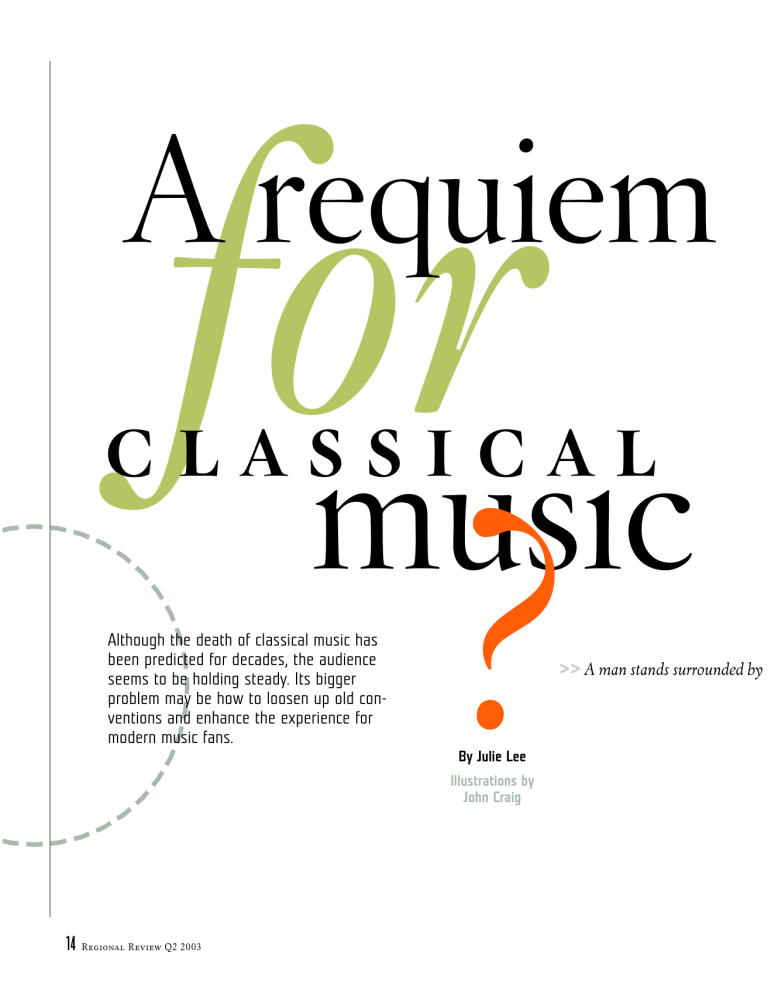
for music A requiem classical Although the death of classical music has been predicted for decades, the audience seems to be holding steady. Its bigger problem may be how to loosen up old conventions and enhance the experience for modern music fans. ? >> A man stands surrounded by By Julie Lee Illustrations by John Craig 14 Regional Review Q2 2003 women. He is tall and handsome with long, flowing hair; the women are worshipful, kneeling at his feet. There is one particularly zealous admirer with large scissors, ready to cut a lock of his hair. If it weren’t for the corsets and bustles, this could be a scene of a rock star being hounded by hysterical female fans. Yet, this is a caricature from 1876 depicting Franz Lizst and admirers after one of his concerts. A lot has changed since then. Today, such an enthusiastic reception is reserved for teen pop idols and movie stars. Even as overall sales of music grew steadily until the late 1990s, the sales of classical music CDs hovered at a scant 3 to 4 percent of the total. Record companies such as BMG Classics are slashing the number of new classical releases or, like CRI (a not-for-profit label which has recorded 42 Pulitzer Prize-winning composers), closing Regional Review Q2 2003 15 altogether. Classical music stations have disappeared in many cities; one-third of the nation’s top 100 radio markets do not have a classical station. After 63 years, ChevronTexaco’s radio broadcast from the Metropolitan Opera House will be off the air next year. Many symphony orchestras are cutting back programs and suffering financial difficulties. The Pittsburgh Symphony is selling its concert hall. A sign of the times: the “Death of Classical Music Archive” on ArtsJournal.com contains more than 50 recent articles on the topic. At the same time, it is easier than ever to buy any classical CD one might desire. A recent search on Amazon.com for Beethoven’s Symphony No. 5 yielded a staggering 874 options, including 276 different recordings of a complete performance of all four movements. The choices included every imaginable compilation (from Beethoven: Greatest Hits to Beethoven: Super Hits) and every possible price point (from $2.98 for a performance by an unnamed orchestra to $101.98 for a boxed set with famed conductor Herbert von Karajan). Previously hardto-find works are also more readily available. As a piano student 20 years ago, I had trouble locating Debussy’s “Children’s Corner” (a suite of miniatures for piano) performed by Walter Gieseking—but Amazon instantly offered up two choices. Moreover, attendance at classical concerts appears to be rising slightly. According to a 1997 survey commissioned by the National Endowment for the Arts, more than 15 percent of respondents attended a classical music event the previous year, a 3 percentage point increase from five years earlier. And while classical’s share of CDs is not large, it appears to have held steady over the past 20 years. So, is classical music dying? Or are the reports of its demise simply exaggerated? Franz Lizst (1811-1886), the first modern virtuoso and international superstar, was known for both his brilliant playing and his scandalous love affairs. 16 Regional Review Q2 2003 A S TA R I S B O R N : A S H O R T H I S T O R Y O F T H E CLASSICAL MUSIC BUSINESS Everybody knows classical music when they hear it. It’s old. It’s serious. It’s stuffy. Yet, classical music is an imprecise term, generally referring to Western music from medieval times to the present day. Most of what is commonly called classical music is indeed old, dating back to the sixth century when church chants were first written down and codified. However, much new classical music is being written right now, and much more is still to be written. During the 2002-2003 season alone, 207 works were premiered worldwide. It is often assumed that all classical music is serious and is written with artistic merit as its purpose. But that is not the case. Classical music can be complex, deep, and intellectually meaty (like Beethoven or Brahms symphonies), but it also can be light, irreverent, and frivolous (like Strauss waltzes). And while knowledge and familiarity can enhance one’s enjoyment of classical music, they are not required, much in the way one needn’t be an Elizabethan scholar to enjoy Shakespeare or a filmstudies major to enjoy movies. Many people enjoy classical music with little or no formal training. Whatever its pretensions, artistic or otherwise, until the 19th century the classical music business was relatively prosaic. The composer was a staff function within the machinery of social organizations like the royal court, which employed musicians to sing and play for worship in the cathedral and for entertainment at the palace. Many prominent composers, including Monteverdi, Haydn, and Mozart, held such positions. These hired composers/conductors/music directors generally worked at the whim of their employers, who were not always interested in music. Haydn is said to have composed the “Surprise” symphony to wake dozing patrons after a big meal and the “Farewell” symphony to send his employer a message that it was time to cut short a stay in the country because the musicians were homesick. Consequently, many famous works in classical music were composed because they were in the job description. For example, J.S. Bach (1685-1750) wrote his cycle of cantatas so that his choir would have a piece to perform each Sunday. And he dedicated the Brandenburg Concertos to a potential employer, as a job application of sorts. By all accounts, Bach was a methodical and industrious employee, “in the business of holding jobs.” He did not set out to create masterpieces of artistic importance; those turned out to be fortunate by-products. The rise of the bourgeois class by the eighteenth century set the stage for change, including the appearance of freelance composers, star performers, and the modern market for music. As music moved out of the salons of aristocracy to the concert halls of the middle class, it became a public commercial activity in which the professional musicians performed for the paying audience. By the nineteenth century, many of the principles gov- The rise of the bou archivo iconografico, s.a./corbis urgeois class set the stage for a new market for classical music erning the classical music business today were already in place. The new system of an organized market for mass consumption of music required two key elements: star performers to attract an audience, and the supporting business apparatus to deliver the star and the music to the public efficiently. There were tickets to sell, seats to fill, and stars to manufacture and market. Which bring us back to Franz Lizst (1811-1886), a Hungarian-born composer-pianist and, along with Nicolò Paganini, the first modern virtuoso and international superstar. First and foremost, there was his brilliant technique. In the words of Felix Mendelssohn, “Lizst has a certain suppleness and versatility in his fingers, as well as a thoroughly musical feeling, which may nowhere find its equal.” But Lizst was also a showman. He heightened the effect of his technique by performing from memory (a requirement on today’s stage) and by refusing to share the stage with other musicians (before him, there were no solo recitals and no instrumentalist gave a concert without others). And not unlike today’s rock stars, his extra-musical activities and scandalous love affairs were integral to his mystique. Although critics and detractors considered him cheap and flashy, those very qualities made him a star. He gave his audience what they wanted. The twentieth century brought additional ways to consume music and new ways to promote star performers. Recordings, radio, television, and eventually the Internet further increased the potential audience for classical music. Tenor Enrico Caruso was the first recording star. His 1904 performance from the opera I Pagliacci became the first record to sell one million copies; and several other artists had top ten hits in the years between 1900 and 1920. Superstar conductors like Arturo Regional Review Q2 2003 17 WHERE’S THE MONEY? THE CASE OF THE RECORDING INDUSTRY Opera singer Enrico Caruso’s 1904 performance of “Vesti la Giubba” from I Pagliacci was the first recording to sell more than one million copies. In spite of the commercial success of its biggest stars, classical music recordings were not traditionally expected to make much of a profit, at least not a quick one. The typical recording sold at a relatively slow rate, two or three thousand on first release, but steadily over a longer period. Walter Legge, arguably the best-known record producer in the history of classical music, said that he wanted to make records that would sell for 20 or 30 years—and 40 years later, many still do. But this also meant that many recordings (especially those by large orchestras) wouldn’t make a profit until they were reissued as part of a midprice or budget series. For the most part, record companies seemed content with the prestige and comparatively small profit margins of their classical recordings or were willing to subsidize them with profits from their pop divisions. They kept their focus on “documenting” star performances. “The major labels all operated on the principle that the best way to make money was to record promiToscanini, Eugene Ormandy, and Leopold Stokowski were nent names in standard repertory. . . [and they] signed exclusuccessful enough to become household names. Although acsive contracts with the biggest artists they could find,” wrote curate sales figures are hard to come by, Ormandy and Toscanimusic critic Terry Teachout in Commentary. Under this regime, Leonard Bernstein, Leontyne Price, Artur Rubinstein, and othni are reported to have sold more than 20 million records each er big names continued to sell records into the 1960s and 1970s. over the course of their careers. And Stokowski shook hands Bernstein, in particular, brought classical music into millions with twentieth-century pop icon, Mickey Mouse, in Disney’s of homes during the 1960s with his television series introduc1940 movie, Fantasia. ing classical music to young people. But cracks were appearing in the tradiIs it possible to make money in today’s classical recordtional business model. The market for ings business without blockbuster crossovers? Absolutely, says Naxos, the world’s bestclassical music and its star performers beselling budget label, with 15 percent of classical CD sales in the U.K., 25 percent in Canada, gan to shrink if not in absolute sales, at and more than 5 percent in the U.S. While the major labels pursued blockbusters, Naxos, least relative to the alternatives: Elvis, the founded in 1987, focused on producing the standard repertory cheaply. “My ambition was Beatles, and Michael Jackson. The exploto make classical recordings available on CD at a price comparable to that of LPs,” states sion of other entertainment options such Klaus Heymann, founder and chairman. as television, movies, and later videogames Think of Naxos as the Southwest Airlines of classical CDs. It delivers classical music only intensified the competition for the auwithout frills and at rock-bottom prices. It hires young or unknown recording artists, dience’s time and pocketbook. many from Eastern Europe, and pays them a flat fee with no added royalties. It keeps Moreover, this stars-and-standardone recording of each work in its catalog, limiting the catalog to about 2,500 titles and repertory approach also resulted in market eliminating duplication of repertoire. It doesn’t waste a lot of money on expensive prosaturation of the core product, the Bachmotions. That way, it can sell its CDs for $6.98, not $16.98. And it sells a lot of CDs. Beethoven-Brahms fare constituting the Enough to be profitable in spite of budget prices. canon. Since a “new” product meant a The other successful strategy focuses on niche markets and nonstandard repertory. recording of an old piece by a young perHyperion, a British label founded in 1980, and others have taken this approach. “I didn’t former or a second recording by a vetersee the point in doing the 103rd version of the New World Symphony, so I went for the an, the number of recordings of a relativemore neglected areas, but not so neglected that nobody would buy them,” said ly small number of pieces eventually Hyperion founder Ted Perry. The label’s first hit was an album of Latin hymns by proliferated. The result was a catalog conHildegard von Bingen (1098-1179), which sold over 150,000 copies. Along with sisting of tens of thousands of titles—the Nonesuch, which released Górecki’s Third Symphony and the works of other contempomajority concentrated in the standard rary composers, Hyperion has shown that record companies can be profitable by exploitrepertory—which was expensive for labels ing a niche market that has been neglected in the catalogs of the major labels. and retailers to maintain and potentially confusing to fans. The industry also underwent several pe- Indie Classical 18 Regional Review Q2 2003 bettmann/corbis Who’s listening Audience demographics paint a mixed picture for the future The stereotype of the classical music fan is someone old, well educated, and rich. But a 1997 survey commissioned by the National Endowment for the Arts suggests that the demographic picture is a bit more complicated. EDUCATION. The audience at classical music concerts is highly educated; about one-quarter went to grad school. But this is only somewhat higher than the audience for musicals or jazz concerts. Less than high school College grad High school grad Grad school educational attainment (in percent) 60 50 AGE. The audience at classical music concerts does 40 not consist only of people ready for an old-age home. More than one-quarter of attendees are under 34 years of age; another half were between 35 and 64. Moreover, the share of adults who listen to classical recordings—about one-third—was fairly constant across all age groups except for the very oldest (over 75 years) who were slightly less likely to do so. 30 20 10 0 Classical music concerts Musical plays Jazz concerts U.S. population INCOME. Everyone knows that rich people are 18 to 34 35 to 54 more likely to go to classical music concerts than poor people, right? Well, sort of. Only 7 percent of those living in households with incomes less than $20,000 attend classical concerts compared to 35 percent of those living in households earning $100,000 or more. But high-income people are also more likely to attend jazz concerts, musicals, and even movies and sporting events. Since tickets cost money, the more a person earns, the higher the participation rate in all these activities. 55 plus age distribution (in percent) 45 40 35 30 25 20 15 10 5 0 Classical music concerts Musical plays Art museums U.S. population Nonetheless, classical music skews old compared to other leisure-time activities such as attending movies, sporting events, and fooling around on the computer, which are all more likely to be engaged in by younger people. source for all data: 1997 Survey of Public Participation in the Arts, National Endowment for the Arts. Classical music concerts Musical plays Sports events Movies percent participating 90 80 70 60 50 40 30 20 10 0 <$20,000 $20-50,000 $50-100,000 household income $100,000+ Regional Review Q2 2003 19 riods of consolidation including, a particularly intense round of mergers in the late 1980s and early 1990s. For example, Decca, a British label founded in 1929, merged with Polygram in 1980 (which itself was formed by a merger of Deutsche Grammophon and Philips in 1972) and then was incorporated into Universal Music after its purchase in 1998. Similarly, RCA (Toscanini’s label) is now part of Bertelsmann, a German conglomerate, and Columbia Records (Vladimir Horowitz’s label) is part of Sony. As a division within a multinational conglomerate, these labels now competed directly with the more lucrative popular music divisions, and faced increasing pressure to maximize profits. THE THREE TENORS The Three Tenors, Placido Domingo, José Carreras, and Luciano Pavarotti, turned into both a franchise and a marketing concept. 20 It was under these circumstances, that classical music experienced its most unprecedented commercial triumph. The phenomenal success of the Three Tenors in the early 1990s changed expectations and set a new standard for the industry. “Gone were the days when it was acceptable for classical music sales to chug along at a few hundred per year. Now they were expected to perform like popular music divisions,” observed Ian Lace in BBC Music Magazine. José Carreras, Placido Domingo, and Luciano Pavarotti, the three tenors of world renown, first sang together as a trio for the 1990 World Cup in Rome. What nobody could have imagined was the extraordinary success of this venture. About 800 million people worldwide saw the television broadcasts, and the recording, The Three Tenors in Concert, became by far the bestselling classical album of all time, with sales exceeding 10 million. The Three Tenors became both a franchise and a marketing concept. They went on to sing at subsequent World Cups (Los Angeles in 1994, Paris in 1998, and Yokohama in 2002), and spawned imitators like the Three Sopranos and even the Three Chinese Tenors. Regional Review Q2 2003 In addition to making the singers extremely rich, The Three Tenors in Concert had an enormous effect on the business. It demonstrated that a classical CD can sell in the millions. In the way that Star Wars changed the movie industry, The Three Tenors instigated the industry’s relentless search for the next blockbuster that would immediately sell millions. Marketing became more expensive and sophisticated as companies worked to amplify small successes into hits. And some predicted this would help build a new, larger audience for classical music. Such efforts have been successful to a point, leading to a string of highly popular crossover albums that topped pop charts. A 1992 recording of Henryk Górecki’s Third Symphony, a mournful work for soprano and orchestra by the contemporary Polish composer—previously more cult figure than superstar—sold more than 1 million CDs. Even more successful was Chant, recorded by Benedictine monks in northern Spain. Originally promoted by EMI Spain as an antidote to stress, the company undertook a U.S. marketing campaign after sales began to rise that included reducing the two-CD recording to one disc, shortening the title from Las Mejores Obras del Canto Gregoriano (The Best of Gregorian Chants) to the snappier Chant, commissioning an eye-catching new cover, and even shooting a video clip to accompany “Alleluia, beatus vir qui suffert.” Sales, in excess of 4 million, probably amount to more copies than all other Gregorian chant CDs combined. Yet, a business strategy based on crossover blockbusters has turned out to be unreliable. Just as nobody had imagined the extraordinary success of The Three Tenors, finding and marketing the next classical mega-hit has been difficult and unpredictable, with little guidance from the three very different hits mentioned above: The Three Tenors is a crowd-pleasing medley of songs including the greatest hits of the opera repertory sung by the reigning tenors of the day; Chant consists of simple, unaccompanied melodies from the very beginning of Western music; and Górecki’s Third Symphony is a somber piece in the minimalist tradition by a modern composer. Notes then senior vice president at Decca (the record label responsible for The Three Tenors): “There are occasional miracles…but such blockbusters are rare. . . . They have to be seen as special, almost freak occurrences.” Moreover, if Amazon’s “customers also bought” links are any indication, such one-time hits don’t appear to have spilled over into increased sales in the standard repertoire. Customers who purchased The Three Tenors have also bought other crossover CDs, like Pavarotti’s Greatest Hits or The #1 Opera Album, but don’t appear to have ventured into traditional opera CDs, like Pavarotti’s Turandot or La Bohéme. While the major recording companies pursued the seductive but elusive lure of mega-hits, a number of companies have been quite successful—commercially and artistically—by taking oth- A business strate reuters newmedia inc./corbis gy based on crossover blockbusters has turned out to be risky er approaches. The label Naxos, for example, records new versions of the standard repertory without star performers to keep costs reasonable; Hyperion and others specialize in recording and releasing less often heard, more adventurous works. (See sidebar on page 18.) The success of these firms suggests that classical music may still have some life in it yet. R E V E R E N C E V S . R E L E VA N C E : THE CASE FOR EXPANDING THE AUDIENCE It is worth noting that concerns about the health of classical music have popped up fairly regularly. In 1980, a New York Times article announced a “classical crisis” in the recording industry. In 1971, another New York Times piece noted a decline in classical radio stations going back to 1967; in 1949, articles in other publications complained of similar circumstances. Yet, a closer look suggests that the demand for classical music seems to have held fairly steady, at least over the past 20 years. During that time, the share of classical recordings has remained relatively stable at about 3 to 5 percent. (The figure briefly reached an unusually high 7 to 8 percent in the late 1980s as classical music buffs replaced their LPs with CDs.) Moreover, according to the National Endowment for the Arts, 30 million adults (16 percent) had attended a classical music event in the previous 12 months—on par with the rates for jazz concerts and plays but smaller than for watching TV (96 percent) or going to the movies (66 percent). However, in reviewing all the evidence for an article published by the Symphony Orchestra Institute, Professor Douglas Dempster, of the Eastman School of Music concluded, “Classical music is more widely heard and available, performed at a higher level of preparation and artistry, Regional Review Q2 2003 21 The Internet may offer new ways to distribute recordings and expand the audience for classical music. both in the U.S. and, I would wager, around the world, than it has ever been before.” So, what is the source of the evident concern? One reason may be that there are simply so many other options competing for our scarce leisure time and our ever-rising disposable income. A hundred years ago, we didn’t have TV. Fifty years ago, there was no Internet. Twenty-five years ago, the $10 billion video game industry was in its infancy. As the entertainment market offers an ever-increasing number of options, classical music’s fight for our attention has become more competitive and makes the classical audience look small, even as it holds on to its share. If Lizst had to vie with the Matrix Reloaded or video games such as Grand Theft Auto III, would he have captured the public’s imagination? Some argue that classical music has more intrinsic value than other forms of entertainment because of its significance for our musical tradition and its intellectual complexity. But whether this makes it more valuable depend on why one listens to music. We may admire the musical facility in Mozart or be challenged by the expansive musical canvas in Mahler, but be more profoundly moved by “Amazing Grace” on a lone bagpipe. Still, classical music’s prevailing culture and conventions do feel increasingly out of sync with contemporary experience. As most people will tell you, a modern classical music concert is an entirely somber, serious affair for performers and audiences alike. It is predictable and almost lifelessly professional. No classical music stage today would tolerate the onstage shenanigans of Vladimir de Pachmann, a world-famous nineteenth-century pianist who earned millions touring and was known to dip each finger in brandy before a recital. Although the dress code has relaxed somewhat in recent years—much to the horror of the old guard—some rules are strictly observed, such as no applause between movements. These conventions may seem unnecessarily restrictive for those who have known only dress-casual workplaces. 22 Regional Review Q2 2003 This widening gap between the conventions of classical music and the rest of society tends to reinforce classical music’s image as music for the economic elite. And yet this image is not entirely borne out by the facts. According to the National Endowment for the Arts, the classical music concert audience is no richer than audiences for jazz or musical plays. (See sidebar on page 19.) This survey shows that the level of participation in all arts rises with income. It is not simply that classical music audiences tend to be richer than other audiences, but that all audiences tend to be richer than average. Moreover, both rich and poor share similar preferences. For example, musical plays are more popular than classical music at each income level, with similar relative participation rates. Perhaps more worrisome is the cultural elitism of many people in the classical music community. The fact that there are 276 versions of Beethoven’s 5th, already tends to foster an atmosphere where someone who can’t tell one from the other is made to feel less than welcome. Even those in the business end, “encouraged the attitude that you have to be able to spell Tchaikovsky backwards to be qualified to buy something,” noted the President of EMI Classics back in 1990. And some classical music proponents criticize any attempt to reach a wider audience as “dumbing down.” They view the enormous popularity of The Three Tenors and other crossover albums as a phenomenon that degrades or reduces the status of classical music. In the words of essayist Joseph Epstein: “The bloody snobbish truth is, I prefer not to think myself part of this crowd [his fellow audience at a Pops concert]. I think myself…much better—intellectually superior, musically more sophisticated, even though I haven’t any musical training whatsoever and cannot follow a score.” This attitude, albeit half-joking, may hurt classical music’s ability to reinvent itself and adapt to the modern audience and the modern world. On the contrary, to emotionally connect to today’s audiences and capture their imaginations will take vision and innovation. But there are examples out there. One of the most unlikely successes on Broadway last year was a production of Puccini’s La Bohéme, the 1896 opera about a doomed love between Mimi, a Parisian seamstress, and Rodolfo, a starving poet. While the music is exactly as Puccini wrote it and the characters sing in Italian, Baz Luhrmann, the director of Strictly Ballroom and Moulin Rouge, reimagined the story set in 1957. More importantly, he ignored the usual opera conventions and hired singers who looked and acted the parts. Although purists criticized the quality of the singing and objected to the use of microphones, Luhrmann’s experiment shows that there is an enthusiastic new audience for classical music if classical music is made relevant. Even in tradition-bound solo recitals, old customs are loosening up. At the end of a recent recital, Maxim Vengerov, a rising twenty-something violinist, picked up a microphone and La Bohéme’s succ ess shows that classical music can excite a modern audience talked to the audience for 20 minutes. On a stage where the only thing usually uttered by the soloist is the announcement of the encores, his entertaining anecdotes and sincere answers to questions left the audience more connected to both the music and the musician. REPRISE Classical music may never be the most popular music. And changes are afoot in the industry—and not only in classical music—as the Internet and other technological advancements roil the landscape and challenge traditional ways of doing business. For example, the initial success of Apple’s iTunes Music Store suggests there may be new and viable ways of buying recorded music over the Internet. These developments may change the ways in which we consume and experience classical mu- sic. But that does not necessarily signal its demise. However, both artists and business people need to think hard about who their future audience is going to be and how to make classical music exciting and relevant to that audience. Whether by delivering neglected repertory, or offering fresh interpretations of old favorites to a small but dedicated audience, or by shedding antiquated conventions and trying to expand into new territory, in the end, successful strategies will need to make people care about the music. These experiments may mean the death of the classical music business as we know it, but also may provide an opportunity for rebirth and renewal.S Julie Lee is a health economist. After years of piano lessons, she is more comfortable as a fan of classical music than as a performer. Regional Review Q2 2003 23

